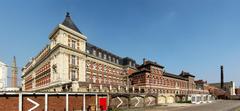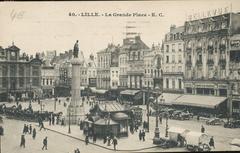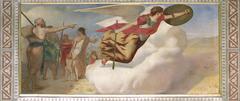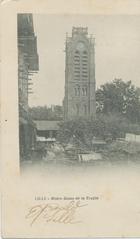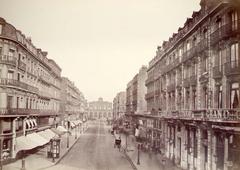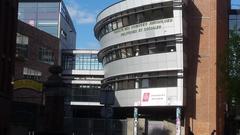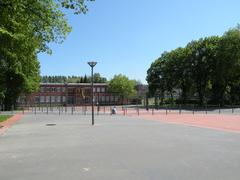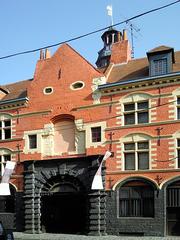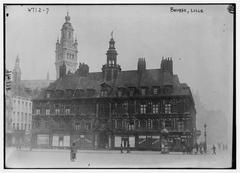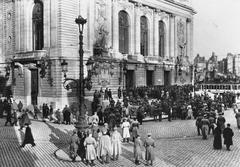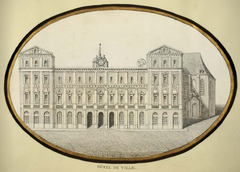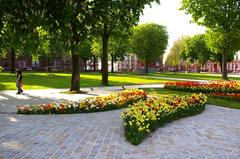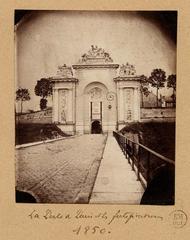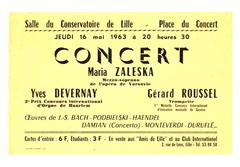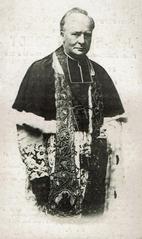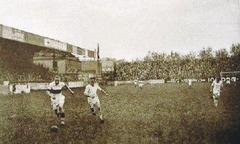Comprehensive Guide to Visiting Lille, Nord, France
Date: 14/08/2024
Captivating Introduction
Ever wondered what it feels like to walk through a living museum where every corner brims with history and culture? Welcome to Lille, Nord, France—a city that seamlessly blends its rich past with vibrant, modern-day charm. Imagine strolling through cobblestone streets, where the echoes of ancient Gauls and medieval knights mix with the buzz of chic cafes and bustling markets. Lille, known as the ‘Island’ derived from its Latin name ‘Īnsula,’ offers a sensory feast for the curious traveler. Picture yourself at La Grand Place, sipping a café au lait while absorbing the breathtaking Flemish Baroque architecture that frames this lively square. Whether you’re an art lover, history buff, or just someone looking to immerse in a cultural extravaganza, Lille promises an unforgettable experience. And the best part? This guide will take you beyond the obvious tourist spots, revealing hidden gems, quirky local customs, and insider tips that only a witty local friend could offer. So, are you ready to explore this captivating city where the past and present dance in delightful harmony? (Wikipedia, Travel2Next, Come Amaviaja)
Table of Contents
- Historical Overview
- Major Attractions
- Cultural Insights
- Insider Tips and Fun Facts
- Local Lingo and Seasonal Magic
- Myths, Legends, and FAQs
- Call to Action
Historical Overview of Lille, Nord, France
A Journey Through Time in Lille
Early History: From Ancient Settlers to Gauls
Lille has been a bustling hub since 2000 BC. The ancient Gauls, including tribes like the Menapians and Nervians, once roamed the lands where chic cafes and cobblestone streets now reside. The name ‘Lille’ stems from the Latin ‘Īnsula,’ meaning ‘island,’ a nod to its marshy origins (Wikipedia).
Medieval Marvels and Legends
During the Middle Ages, Lille was the jewel of the County of Flanders and a political powerhouse. The city was the stage for epic battles and daring legends like ‘Lydéric and Phinaert,’ dating back to 640 AD. Picture knights in shining armor and bustling market squares as you wander through Vieux Lille today (Wikipedia).
The French Connection: From Siege to Citadel
Lille’s strategic charm caught the eye of many, including Louis XIV. The French sieges in 1641 and 1645 were followed by the triumphant capture in 1667. Louis XIV built the Citadel and new quartiers like Saint-André to win over the locals (Wikipedia).
Industrial Boom and Revolutionary Whispers
In the 18th century, Lille was a staunchly Catholic city, barely touched by the Revolution’s fervor. By the 19th century, it morphed into an industrial titan, with textiles and machinery at its heart (Wikipedia).
Wars and Resilience: 20th Century Struggles
Lille’s spirit was tested by both World Wars. Occupied by German forces, the city endured and rebuilt. By 1944, British, Canadian, and Polish troops liberated Lille, a testament to its unyielding spirit (Wikipedia).
Modern Lille: A Fusion of Past and Future
Post-WWII, Lille reinvented itself. The creation of the Euralille business district in 1988 and the arrival of the TGV and Eurostar in 1994 turned it into a European hub. With over 110,000 students, it’s a buzzing academic center. The city’s 17th-century charm in Vieux Lille, with its red brick houses and cobblestones, remains a delightful contrast to its modern vibrancy (Wikipedia).
Major Attractions in Lille, Nord, France
Welcome to Lille: A City of Surprises!
Picture this: cobblestone streets, centuries-old architecture, and the aroma of freshly baked croissants wafting through the air. Welcome to Lille, a city where history meets hipster vibes, and every corner has a story to tell. Whether you’re a history buff, an art aficionado, or just someone looking for a good time, Lille has something special for you. Ready to explore? Let’s dive into some of Lille’s must-see spots and hidden treasures.
The Heartbeat of the City: La Grand Place
Start your adventure at La Grand Place, the bustling square that’s the lifeblood of Lille. Surrounded by stunning Flemish Baroque buildings, including the 17th-century Vieille Bourse, this square is a hive of activity. Sip on a café au lait at one of the many outdoor cafes, watch street performers, or simply soak in the vibrant atmosphere (source).
The Enchanted Courtyard: Vieille Bourse
Just a stone’s throw from La Grand Place, the Vieille Bourse is a gem you won’t want to miss. This 17th-century building, with its 24 identical houses surrounding a courtyard, is a marvel of Flemish Renaissance architecture. Browse through second-hand books, watch a chess game, or just admire the intricate details and vibrant colors (source).
Sky-High Views: Beffroi de Lille
For the best panoramic views of Lille, head to the Beffroi de Lille. This 104-meter-tall UNESCO World Heritage Site, designed by Emile Dubuisson, is inspired by the triangular gable of Flemish houses. Take the elevator up and feast your eyes on the breathtaking cityscape. Pro tip: Book your tickets online to skip the line! (source)
The Queen of Citadels: The Citadel
Designed by military architect Sébastien Le Prestre, Marquis de Vauban, the Citadel of Lille is a fortress like no other. Known as the “Queen of Citadels,” it stands as a remarkable example of 17th-century military architecture. The Citadel is still in use today by the French military, but its surrounding park is open to the public, offering a peaceful retreat with walking trails and picnic spots (source).
Cultural Insights: Discovering Lille’s Hidden Charms
Flemish Heritage and Architecture
Lille’s cultural landscape is deeply rooted in its Flemish heritage, as seen in the city’s distinctive architecture. Stroll through Vieux Lille, the old town, and let your feet guide you along cobblestone streets lined with baroque buildings and intricately gabled roofs. The Vieille Bourse, a 17th-century marvel, now buzzes with book fairs and cultural events—a lively hub of activity that was once a stock exchange.
Art and Museums
Art aficionados, rejoice! Lille boasts a thriving arts scene with galleries and museums aplenty. The Palais des Beaux-Arts, housed in a Belle Époque building, is France’s second-largest fine arts museum after the Louvre. Marvel at masterpieces by Monet, Raphael, and Picasso. For a unique experience, visit the Musée d’Art et d’Industrie André Diligent in Roubaix, a former Art Deco swimming pool now showcasing modern art.
Festivals and Traditions
Lille knows how to throw a party! The Braderie de Lille, held the first weekend of September, is Europe’s largest flea market, drawing millions of visitors and over 10,000 exhibitors. Imagine the thrill of hunting for treasures while enjoying food fairs, carnival rides, and street performances. In September, don’t miss the Fête de la Déesse, a carnival celebrating the city’s vibrant spirit with colorful parades, music, and street performances.
Gastronomy
Prepare your taste buds for Lille’s culinary delights—a fusion of French and Flemish flavors. Savor dishes like creamy waterzooi stew or the hearty potjevleesch terrine. Don’t miss out on the local specialty moules-frites (mussels and fries), especially during the Braderie. Indulge in local cheeses and beers that are integral to the region’s gastronomic culture.
Performing Arts
Lille’s performing arts scene is alive and kicking, with theaters and cultural centers showcasing a variety of performances. The Théâtre du Nord, housed in a former 1717 guardhouse, is a hotspot for theatrical productions. Street performances are a common sight during festivals like the Fête de la Déesse and the Braderie de Lille.
Street Art
Discover Lille’s burgeoning street art scene in the Saint-Sauveur Moulins district. Thanks to the International Biennial of Wall Art, the city is adorned with colorful murals and vibrant street art installations. Join a guided tour by Collectif Renart to explore these hidden gems.
Music and Nightlife
Lille’s music scene is as diverse as it is vibrant. From classical concerts to contemporary gigs, the city has it all. Don’t miss the Lille Piano(s) Festival, featuring performances by renowned pianists. When the sun sets, Vieux Lille transforms into a nightlife haven with bars, clubs, and live music venues to suit every taste.
Shopping and Markets
Shopping in Lille offers something for everyone. The Rue de Bethune is perfect for high street shopping, while Vieux Lille is home to luxury brands like Louis Vuitton and Hermès. For a more traditional experience, visit the Wazemmes Sunday market, one of France’s largest markets, where you’ll find fresh produce, antiques, and the uplifting sounds of accordion music.
Local Customs
When in Lille, do as the Lilleois do! Enjoy a leisurely meal at one of the city’s many brasseries, savoring dishes like carbonade flamande (beer-braised beef stew) and tarte au maroilles (cheese tart). Gather at the Grand Place, the bustling main square, and experience the city’s social heartbeat.
Educational and Cultural Institutions
Lille is not just about fun—it’s a hub of learning and culture too. The Université de Lille, one of France’s largest universities, hosts numerous cultural events, lectures, and exhibitions, enriching the city’s intellectual life.
Insider Tips and Fun Facts
- Getting There: Skip the pricey flights to Lille’s airport. Fly to Brussels Charleroi and hop on a bus for 15 euros. It’s an adventure of its own! (Come Amaviaja).
- Accommodation: From cozy hostels to luxury hotels, Lille has it all. Pro tip: Book early during events like the Braderie de Lille.
- Sightseeing Challenge: How about a mini-quest? Find the best view from the belfry of the Hôtel de Ville de Lille, and snap a panoramic shot! (Travel2Next).
- Cultural Activities: LaM is a treat for art lovers. Look out for masterpieces by Cézanne, Braque, Picasso, and Miro. (Travel2Next).
- Nightlife: Dive into Lille’s nightlife in the streets of Masséna and Solferino. It’s a student haven with something for everyone (Come Amaviaja).
Local Lingo and Seasonal Magic
Learn a bit of the local lingo! ‘Ch’ti’ is the regional dialect. Try saying ‘Hein?’ (pronounced ‘eh’) for ‘What?’ You’ll fit right in!
Lille transforms with the seasons. Spring brings blossoms to the Jardin des Plantes, while winter lights up the city with Christmas markets. Each season offers a unique vibe, so plan accordingly.
Myths, Legends, and FAQs
Did you know Lille was once thought to be haunted by the ghost of Phinaert? Myth busted: It’s just a fun local legend.
FAQs:
- Is Lille safe? Absolutely! Just practice common sense as you would in any city.
- What’s the best time to visit? Spring and fall are ideal for pleasant weather and fewer crowds.
Call to Action
As your journey through Lille comes to an end, it’s clear that this city is much more than just a pretty face. From its ancient roots as a settlement around 2000 BC to its current status as a bustling European hub, Lille has continually reinvented itself while preserving its rich cultural heritage. Imagine the resilience of its people, rebuilding from the ruins of war to create a vibrant, modern cityscape that still holds onto its historical charm. Whether you’re marveling at the panoramic views from the Beffroi de Lille or hunting for treasures at the Braderie de Lille, this city offers a unique blend of experiences that cater to every interest. And let’s not forget the local culinary delights—ever tried potjevleesch or carbonnade flamande? Trust us, your taste buds will thank you. So, why not take the plunge and explore Lille with the Audiala app? Offering expertly crafted audio guides, Audiala will be your perfect companion, revealing hidden gems and local secrets that you won’t find in any guidebook. Download Audiala now, and let the adventure begin! (Wikipedia, Travel2Next, Come Amaviaja)
References
- Wikipedia, 2023 source Wikipedia
- Becoming Carmen, 2023 source Becoming Carmen
- Travel2Next, 2023 source Travel2Next
- Come Amaviaja, 2023 source Come Amaviaja
- PlanetWare, 2023 source PlanetWare
- The Crazy Tourist, 2023 source The Crazy Tourist
- France.fr, 2023 source France.fr
- Over Your Place, 2023 source Over Your Place
- The Good Life France, 2023 source The Good Life France





